Analysis of Cultural Perceptions of the Intangible Cultural Heritage of Chinese Porcelain Inlay: An Investigation Based on Social Media Data
Abstract
1. Introduction
1.1. Research Background
1.2. Research Objects: Chinese Porcelain Inlay
1.3. Literature Review
1.4. Problem Statement and Objectives
2. Materials and Methods
2.1. Input Data and Preprocessing
2.2. Analytical Methods
3. Results
3.1. Word Frequency Analysis and Word Cloud Diagram
3.2. Semantic Network Analysis
3.3. Emotional Imagery Analysis
3.4. LDA Topic Model Analysis
4. Discussion
5. Conclusions
Author Contributions
Funding
Institutional Review Board Statement
Informed Consent Statement
Data Availability Statement
Conflicts of Interest
References
- Kurin, R. Safeguarding intangible cultural heritage: Key factors in implementing the 2003 Convention. Int. J. Intang. Herit. 2007, 2, 9–20. [Google Scholar]
- UNESCO. Convention for the Safeguarding of the Intangible Cultural Heritage. In Proceedings of the 32nd Session of General Conference of the United Nations Educational, Scientific and Cultural Organization, Paris, France, 29 September–17 October 2003; Available online: https://ich.unesco.org/en/convention (accessed on 10 December 2024).
- Newell, P. The PRC’s Law for the Protection of Cultural Relics. Art Antiquity L. 2008, 13, 1. [Google Scholar]
- Zhang, J. Folklore in China: Past, Present, and Challenges. Humanities 2018, 7, 35. [Google Scholar] [CrossRef]
- Yu, P.K. Cultural relics, intellectual property, and intangible heritage. Temp. L. Rev. 2008, 81, 433. [Google Scholar]
- Liu, Y.; Li, X. The Book of Songs; Zhonghua Book Company: Beijing, China, 2011. [Google Scholar]
- Liu, Z. Repatriation of Cultural Objects: The Case of China. Ph.D. Thesis, Universiteit van Amsterdam [Host], Amsterdam, The Netherlands, 2015. [Google Scholar]
- Wen, X. The Song Rediscovery of Chang’an. J. Song-Yuan Stud. 2024, 53, 127–190. [Google Scholar] [CrossRef]
- Yuan, S.; Li, Y.; Yang, S. International Communication of Chinese Intangible Cultural Heritage from a Cross-Cultural Perspective: Taking Chinese Porcelain Inlay Craft as an Example. J. Jianghan Pet. Univ. Work. 2024, 37, 71–73. Available online: https://chn.oversea.cnki.net/KCMS/detail/detail.aspx?dbcode=CJFD&dbname=CJFDAUTO&filename=JSZD202405024&uniplatform=OVERSEA&v=rJg0XvGZJ2qOhSvae1iWgOiWYG-EndfOw5hzW8KcOAFIiSsIai2liEbbyWuK9dUq (accessed on 16 November 2024). (In Chinese).
- Li, Y.; Xu, M.; Wang, X. On the Presentation of Confucianism in the Chinese Porcelain Inlay of Chaoshan Traditional Architectural Decoration. Design Creates the Future—Proceedings of the 2021 Young Doctor (International) Forum. 2021, p. 10. Available online: https://chn.oversea.cnki.net/KCMS/detail/detail.aspx?dbcode=IPFD&dbname=IPFDLAST2023&filename=ZDCB202105001023&uniplatform=OVERSEA&v=x8G0ipCLRzesInIg3HMAd3CD4oiTWol6yIE9xOuttVJZd53AhHxbQ3KUV-J3yq_DM19cZgbqyWQ%3d (accessed on 10 December 2024). (In Chinese).
- Li, Y.; Yin, J.; Wang, X. Research on the craftsmanship and artistic characteristics of Chinese porcelain inlay in Lingnan traditional architectural decoration. Ind. Des. 2022, 134–136. Available online: https://chn.oversea.cnki.net/KCMS/detail/detail.aspx?dbcode=CJFD&dbname=CJFDLAST2022&filename=MEIC202205001&uniplatform=OVERSEA&v=XRZSNG8aBCWgd0OIWgrXYnURi9BTCeThhhd0bj5zebrS3rZ6D37Q0MmEdMq_TLy6 (accessed on 10 December 2024). (In Chinese).
- Wen, P. Investigation report on the workshop of Chinese porcelain inlay artists in Chaoshan. Decoration 2008, 94–96. Available online: https://chn.oversea.cnki.net/KCMS/detail/detail.aspx?dbcode=CJFD&dbname=CJFD2008&filename=ZSHI200802042&uniplatform=OVERSEA&v=vYnR1vOGKclEdJ-zQFJvFddOClZg5H8ZVteWkw4j9D5fwTs67u5tFi4vwVn7vwmL (accessed on 10 December 2024). (In Chinese).
- Lin, M. Guangdong Arts and Crafts Historical Materials; Guangdong Society of Arts and Crafts: Guangzhou, China, 1988. [Google Scholar]
- Yan, C. Porcelain Road. A Brief History of Chinese Imperial Porcelain: From Song Dynasty to Qing Dynasty; Springer Nature: Singapore, 2024; pp. 387–414. [Google Scholar]
- Shen, G. The Influence of the Maritime Silk Road on Lingnan Culture; Sun Yat-sen University Press: Guangzhou, China, 2017. [Google Scholar]
- Wei, B.; Zhao, H.; Chen, Z.; Hong, X.; Wei, Z.; Chen, X.; Chen, S.; Lin, R. Correlation Analysis for the Inheritance Pathways of Inlaid Porcelain Techniques under Rural Revitalization: Case Study of Chaoshan Region, China. J. Electr. Syst. 2024, 20, 870–881. [Google Scholar]
- Cao, Y.; Lu, Y. Analysis on porcelain inlay decoration in traditional buildings in Chaozhou. In Proceedings of the 7th International Conference on Arts, Design and Contemporary Education (ICADCE 2021), Online, 25–26 May 2021; Atlantis Press: Amsterdam, The Netherlands, 2021; pp. 111–116. [Google Scholar] [CrossRef]
- Scott, G.R. The cultural property laws of Japan: Social, political, and legal influences. Pac. Rim L. Pol’y J. 2003, 12, 315. [Google Scholar]
- Labadi, S. UNESCO, Cultural Heritage, and Outstanding Universal Value: Value-Based Analyses of the World Heritage and Intangible Cultural Heritage Conventions. 2013. Available online: https://unesdoc.unesco.org/ark:/48223/pf0000220763 (accessed on 10 December 2024).
- Alivizatou, M. The UNESCO programme for the proclamation of masterpieces of the oral and intangible heritage of humanity: A critical examination. J. Mus. Ethnogr. 2007, 34–42. [Google Scholar]
- Xiang, Y. World Intangible Cultural Heritage; Ningxia Renmin Press: Yinchuan, China, 2007. [Google Scholar]
- Chen, D. A preliminary study of the “originality” of traditional Chinese architectural crafts heritage—The example of large woodworking crafts. Hist. Archit. 2009, 25, 146–153. Available online: https://chn.oversea.cnki.net/KCMS/detail/detail.aspx?dbcode=CCJD&dbname=CCJDLAST2&filename=JNZS200902013&uniplatform=OVERSEA&v=-GGg3nr5jIIKJ0p7kMLiN5yDNpX4dp73a_UL61me_a2mLSNa_IAod5ZK0mERpwVc (accessed on 10 December 2024). (In Chinese).
- Li, X. Northern Jiangsu Traditional Building Techniques; Southeast University Press: Nanjing, China, 2014. [Google Scholar]
- Fang, L. On the Inheritance of Intangible Cultural Heritage and the Development of Diversity in Contemporary Society—The Revival of Traditional Handicrafts in Jingdezhen as an Example. Natl. Arts 2015, 1, 71–83. Available online: https://chn.oversea.cnki.net/KCMS/detail/detail.aspx?dbcode=CJFD&dbname=CJFDLAST2015&filename=MZYS201501014&uniplatform=OVERSEA&v=rwecD2pjwGy0KTXLgJMpUNnti4x6FaL0ssc8U8TBw51_dBW01Ak8rIwivUaChtLC (accessed on 10 December 2024). (In Chinese).
- Ou, J.; Wen, J. Research on Chaoshan Porcelain Inlay Craftsmanship; Shenzhen Newspaper Group Publishing House: Shenzhen, China, 2018. [Google Scholar]
- Chen, A. Craftsmanship Follows the Times—A Case Study of Traditional Craft Revitalization; China Light Industry Press: Beijing, China, 2019. [Google Scholar]
- Zhong, F. Creative Transformation and Innovative Development of Lingnan Traditional Architectural Culture-Taking the Architecture Reconstruction Design of Liwan District in Guangzhou as an Example. J. Physics: Conf. Ser. 2020, 1649, 012014. [Google Scholar] [CrossRef]
- Min, X.; Ji, T. Toward Systematic Conservation: Exploring the Elements of Cultural Ecology of Non-Heritage Handicrafts. J. Nanjing Univ. Arts (Fine Arts Des.) 2023, 6, 70–76. Available online: https://chn.oversea.cnki.net/KCMS/detail/detail.aspx?dbcode=CJFD&dbname=CJFDLAST2024&filename=NJYS202306014&uniplatform=OVERSEA&v=UxnW80e6IdvEvSDMHAbHrkFf_xobEIAYdQtellE0vxbA29IIDeCFS36Natpa562a (accessed on 10 December 2024). (In Chinese).
- Pearce, W.; Özkula, S.M.; Greene, A.K.; Teeling, L.; Bansard, J.S.; Omena, J.J.; Rabello, E.T. Visual cross-platform analysis: Digital methods to research social media images. Inf. Commun. Soc. 2020, 23, 161–180. [Google Scholar] [CrossRef]
- Wu, Y.; Cao, N.; Gotz, D.; Tan, Y.P.; Keim, D.A. A survey on visual analytics of social media data. IEEE Trans. Multimed. 2016, 18, 2135–2148. [Google Scholar] [CrossRef]
- Felt, M. Social media and the social sciences: How researchers employ Big Data analytics. Big Data Soc. 2016, 3, 2053951716645828. [Google Scholar] [CrossRef]
- Ghani, N.A.; Hamid, S.; Hashem IA, T.; Ahmed, E. Social media big data analytics: A survey. Comput. Hum. Behav. 2019, 101, 417–428. [Google Scholar] [CrossRef]
- Chen, S.; Yuan, X.; Wang, Z.; Guo, C.; Liang, J.; Wang, Z.; Zhang, X.; Zhang, J. Interactive visual discovering of movement patterns from sparsely sampled geo-tagged social media data. IEEE Trans. Vis. Comput. Graph. 2015, 22, 270–279. [Google Scholar] [CrossRef]
- Mulyani, Y.P.; Saifurrahman, A.; Arini, H.M.; Rizqiawan, A.; Hartono, B.; Utomo, D.S.; Spanellis, A.; Beltran, M.; Nahor, K.M.B.; Paramita, D.; et al. Analyzing public discourse on photovoltaic (PV) adoption in Indonesia: A topic-based sentiment analysis of news articles and social media. J. Clean. Prod. 2024, 434, 140233. [Google Scholar] [CrossRef]
- Themistocleous, K. Model reconstruction for 3d vizualization of cultural heritage sites using open data from social media: The case study of Soli, Cyprus. J. Archaeol. Sci. Rep. 2017, 14, 774–781. [Google Scholar] [CrossRef]
- Ai, Z.; Chiu, D.K.; Ho, K.K. Social Media Analytics of User Evaluation for Innovative Digital Cultural and Creative Products: Experiences Regarding Dunhuang Cultural Heritage. ACM J. Comput. Cult. Herit. 2024, 17, 1–25. [Google Scholar] [CrossRef]
- Feng, J.; Li, Y.; Wu, P. Conflicting images of the Great Wall in cultural heritage tourism. Crit. Arts 2017, 31, 109–127. [Google Scholar] [CrossRef]
- Liang, X.; Hua, N.; Martin, J.; Dellapiana, E.; Coscia, C.; Zhang, Y. Social media as a medium to promote local perception expression in China’s World Heritage sites. Land 2022, 11, 841. [Google Scholar] [CrossRef]
- Qiu, Q.; Zhang, M. Using content analysis to probe the cognitive image of intangible cultural heritage tourism: An exploration of Chinese social media. ISPRS Int. J. Geo-Inf. 2021, 10, 240. [Google Scholar] [CrossRef]
- Tan, J. A Critical Research on Xiaohongshu for Information Sharing for Chinese Teenagers. Prof. Inf. 2024, 33, 1–15. [Google Scholar] [CrossRef]
- Wang, Y.; Peng, B.; Tang, X. Translingual practice as a discursive strategy to shape lifestyle and cultural identity. Humanit. Soc. Sci. Commun. 2024, 11, 1–15. [Google Scholar] [CrossRef]
- Qiu, Q. Identifying the role of intangible cultural heritage in distinguishing cities: A social media study of heritage, place, and sense in Guangzhou, China. J. Destin. Mark. Manag. 2023, 27, 100764. [Google Scholar] [CrossRef]
- The State Council. Circular of the State Council on Publishing the List of the Second Batch of National Intangible Cultural Heritage and the Extended List of the First Batch of National Intangible Cultural Heritage. 2011. Available online: https://www.gov.cn/zwgk/2008-06/14/content_1016331.htm (accessed on 10 December 2024).
- The State Council. Circular of the State Council on Publishing the List of the Third Batch of National Intangible Cultural HERITAGE. 2011. Available online: https://www.gov.cn/zwgk/2011-06/09/content_1880635.htm (accessed on 10 December 2024).
- Xue, Y. Modern Lingnan Architectural Decoration Research. Doctoral Thesis, South China University of Technology, Guangzhou, China, 2012; pp. 161–166. [Google Scholar]
- Wang, Y. A Study on the Culture of Temple Roofs Decoration in Southern Fujian, Eastern Guangdong and Taiwan. Doctoral Thesis, South China University of Technology, Guangzhou, China, 2014; pp. 1–2. [Google Scholar]
- Wu, Q. Artistic characteristics and inheritance and development of Chinese porcelain inlay in Chaoshan. J. Zhaoqing Univ. 2024, 45, 124–128. Available online: https://chn.oversea.cnki.net/KCMS/detail/detail.aspx?dbcode=CJFD&dbname=CJFDAUTO&filename=SJDI202406019&uniplatform=OVERSEA&v=AZM8f20_zPq8tAdl9lgDuhZuFo7ngXZJUV-7pOtt5GxqjPSqXN8Me6BDL4kaZBI9 (accessed on 10 December 2024). (In Chinese).
- Yin, J.; Lin, T. Memory mapping and schematic reproduction of Chinese porcelain inlay art in Lingnan architectural decoration. J. Nanjing Univ. Arts (Fine Arts Des.) 2023, 85–89. Available online: https://chn.oversea.cnki.net/KCMS/detail/detail.aspx?dbcode=CJFD&dbname=CJFDLAST2023&filename=NJYS202304014&uniplatform=OVERSEA&v=UxnW80e6IdvOjDaGy3fpsw_S7ibXiH6bHio8k2KB6iYEBim1lNRZVKb8lSHvI9oi (accessed on 10 December 2024). (In Chinese).
- Zhang, H.; Feng, H. Research on Chinese Porcelain Inlay Decorative Art in Ancient Houses in Eastern Guangdong. Art Educ. 2022, 213–216. Available online: https://chn.oversea.cnki.net/KCMS/detail/detail.aspx?dbcode=CJFD&dbname=CJFDLAST2022&filename=YSJY202208049&uniplatform=OVERSEA&v=Z14qHSme_2mQArAHW-frJVaIGHZ1RSUpVxQPdykxeiI5tcM-h7Ee2RtZ8EhG2gKq (accessed on 10 December 2024). (In Chinese).
- Zhang, T.; Zhang, J.; Yan, R. Synergistic Diverse Perspective for Topic Evolution Analysis on Weibo. In Document Analysis and Recognition—ICDAR 2024; Barney Smith, E.H., Liwicki, M., Peng, L., Eds.; ICDAR 2024; Lecture Notes in Computer Science; Springer: Cham, Switzerland, 2024; Volume 14807. [Google Scholar] [CrossRef]
- Ruan, G.; Xia, L.; Wen, X.; Dong, Y. Exploring the Dynamic Interplay of User Characteristics and Topic Influence on Weibo: A Comprehensive Analysis. J. Knowl. Econ. 2024, 1–28. [Google Scholar] [CrossRef]
- Qin, M.; Qiu, S.; Zhao, Y.; Zhu, W.; Li, S. Graphic or short video? The influence mechanism of UGC types on consumers’ purchase intention—Take Xiaohongshu as an example. Electron. Commer. Res. Appl. 2024, 65, 101402. [Google Scholar] [CrossRef]
- Das, R.; Singh, T.D. Multimodal sentiment analysis: A survey of methods, trends, and challenges. ACM Comput. Surv. 2023, 55, 1–38. [Google Scholar] [CrossRef]
- Vretos, N.; Nikolaidis, N.; Pitas, I. Video fingerprinting using Latent Dirichlet Allocation and facial images. Pattern Recognit. 2012, 45, 2489–2498. [Google Scholar] [CrossRef]
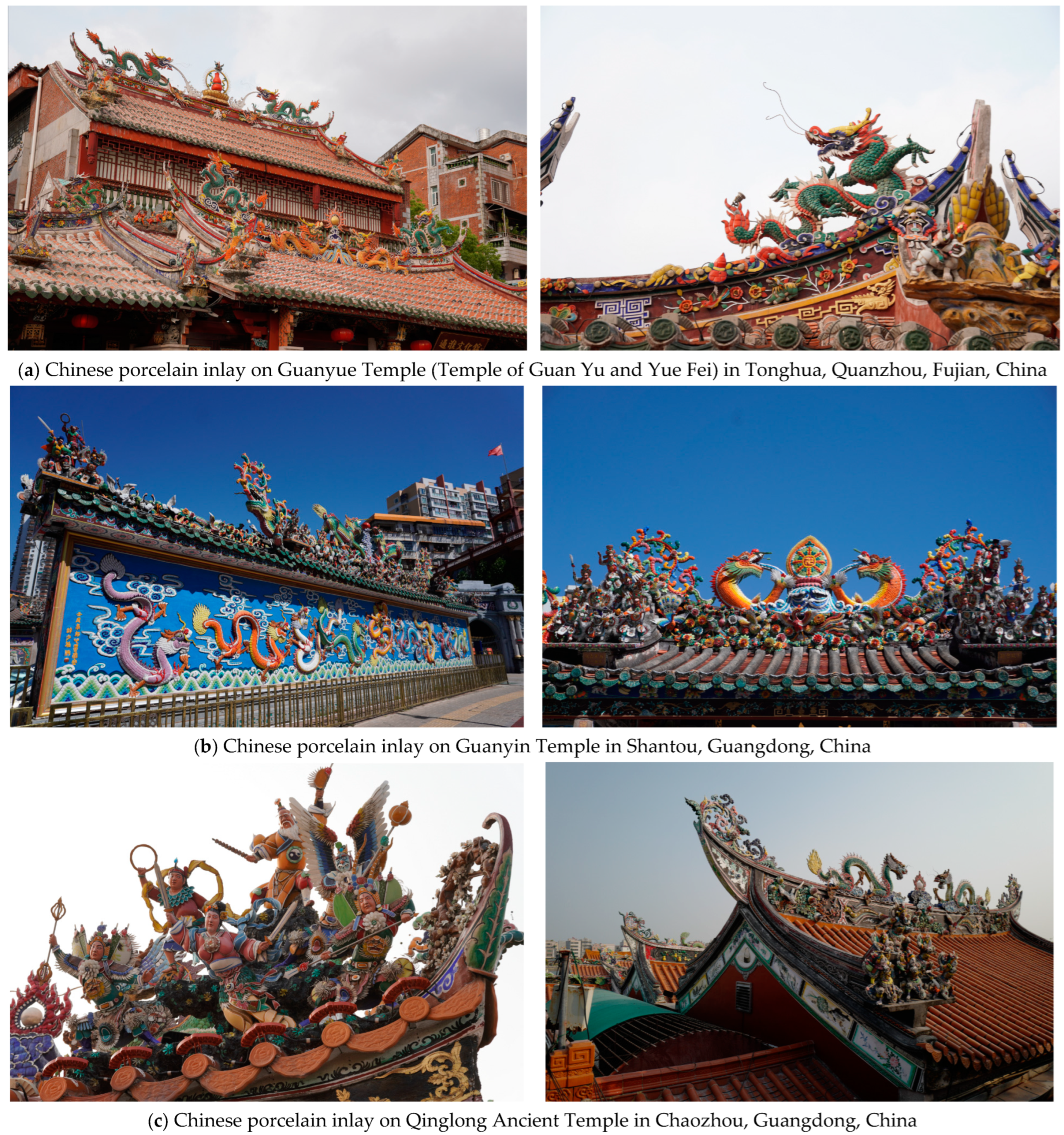
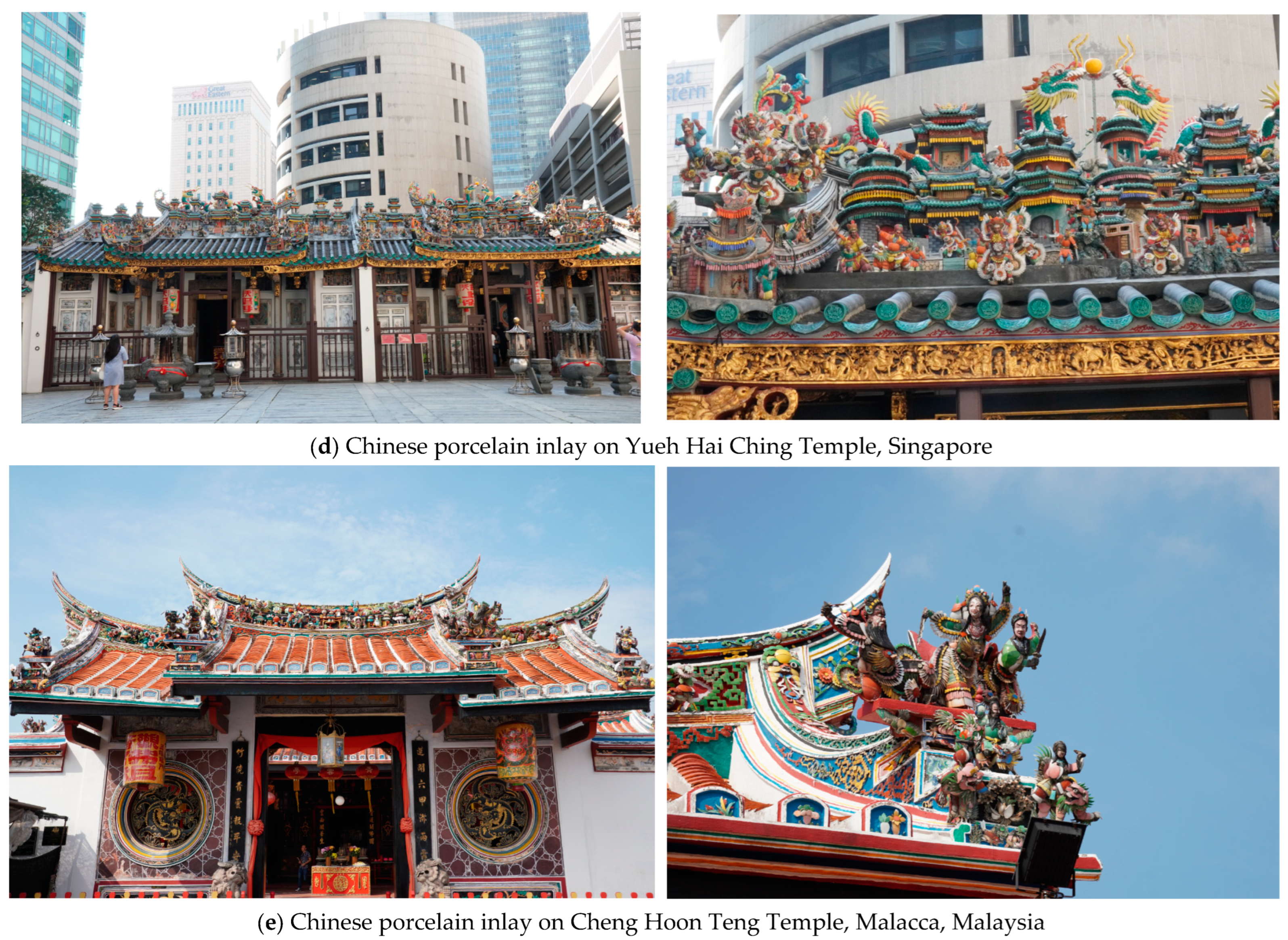
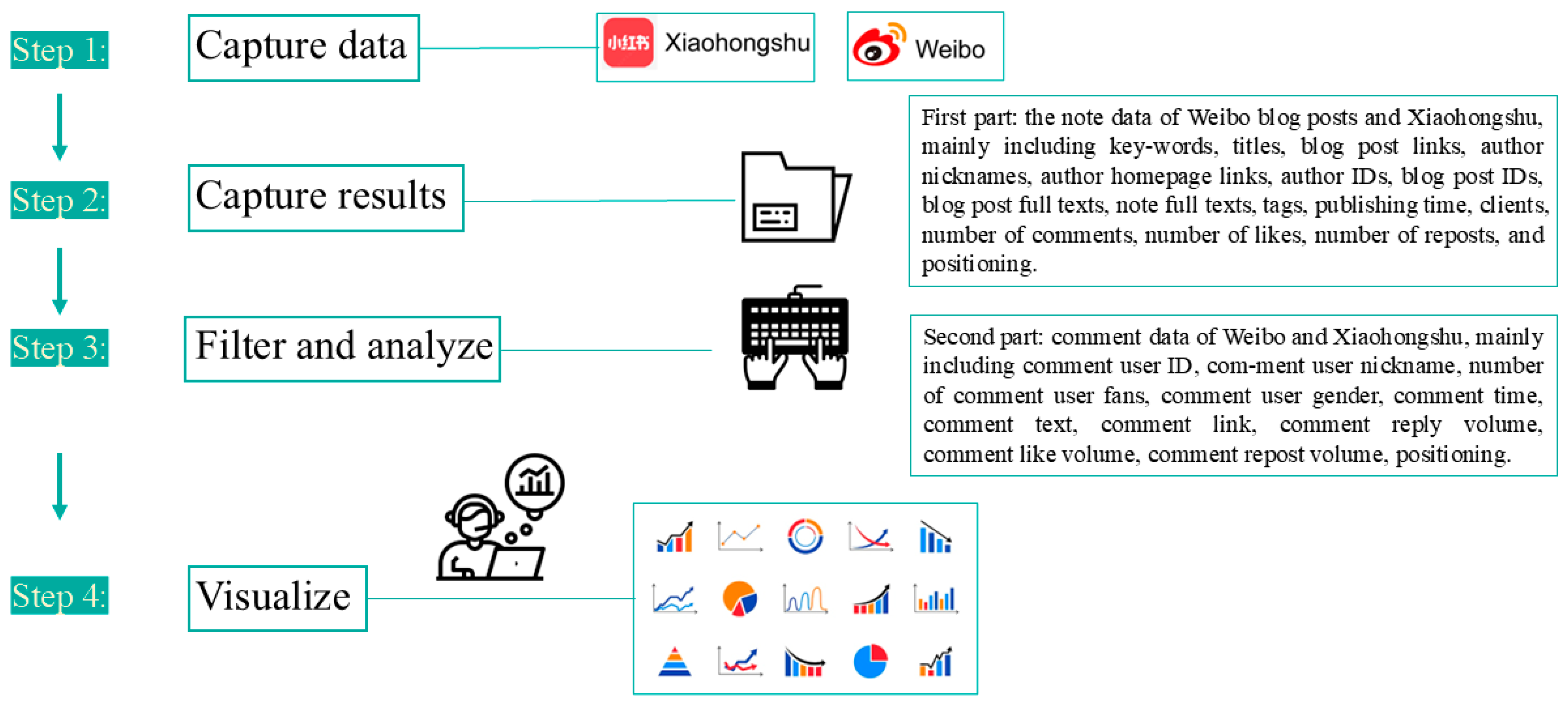
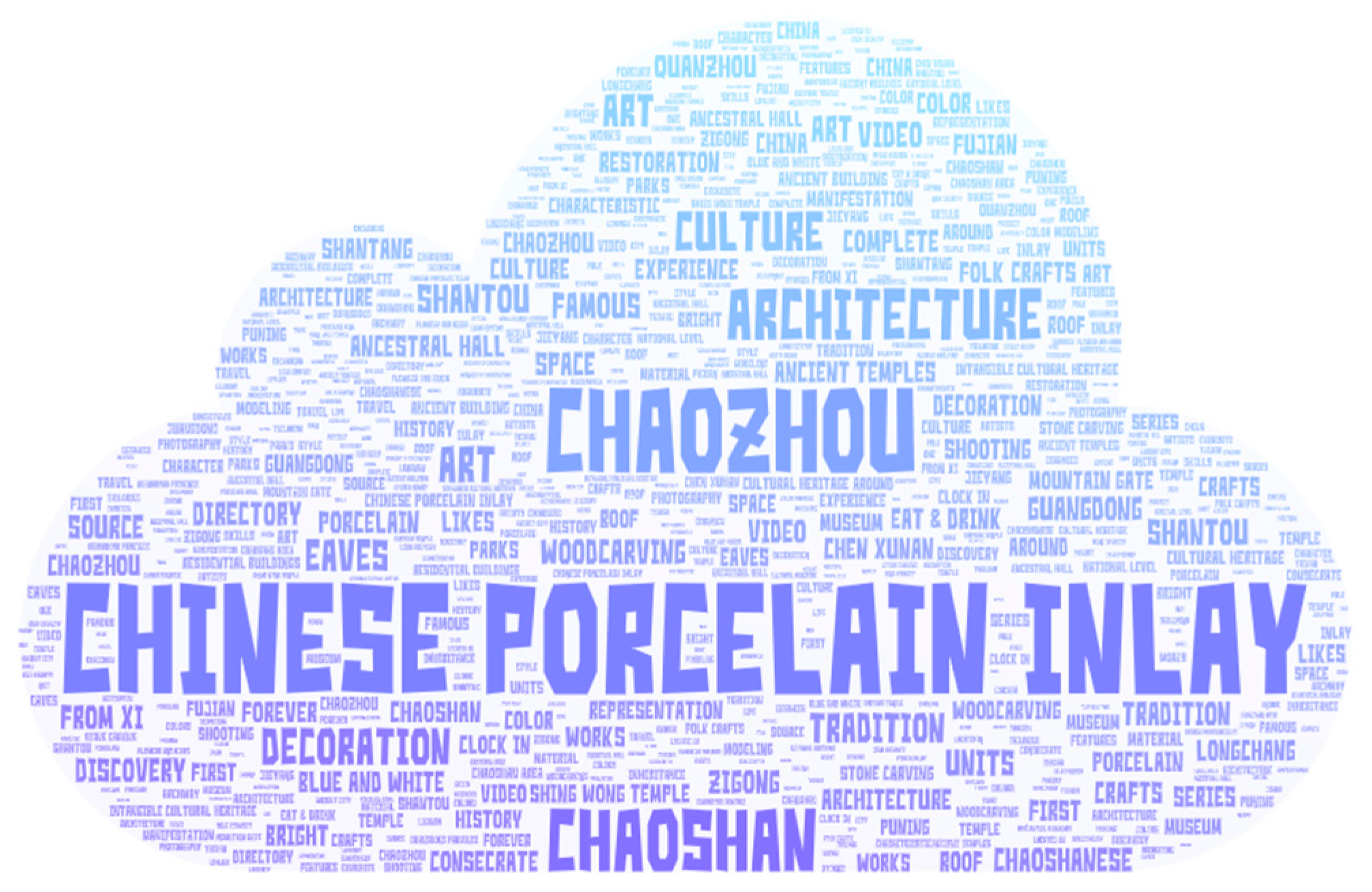
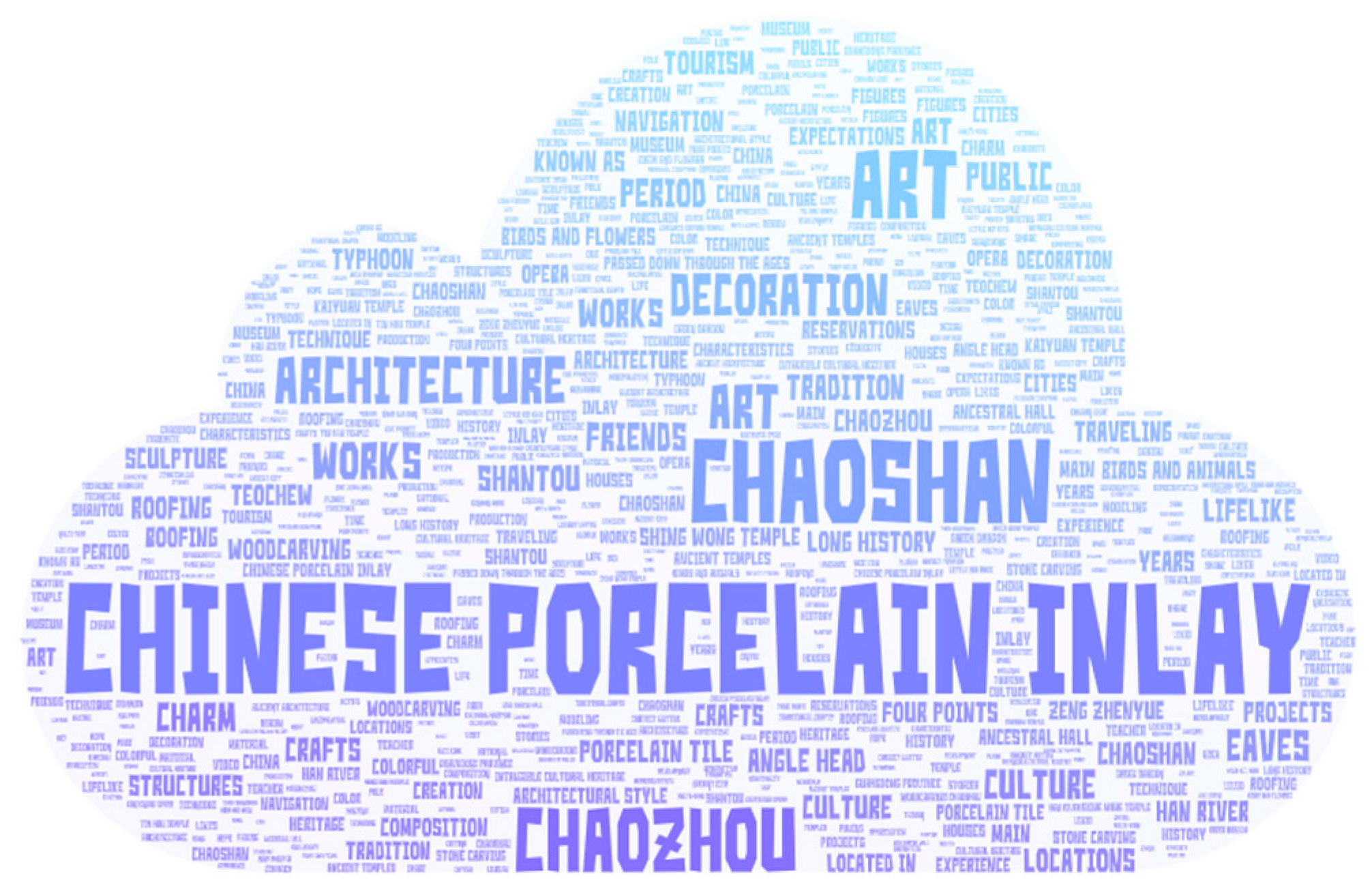


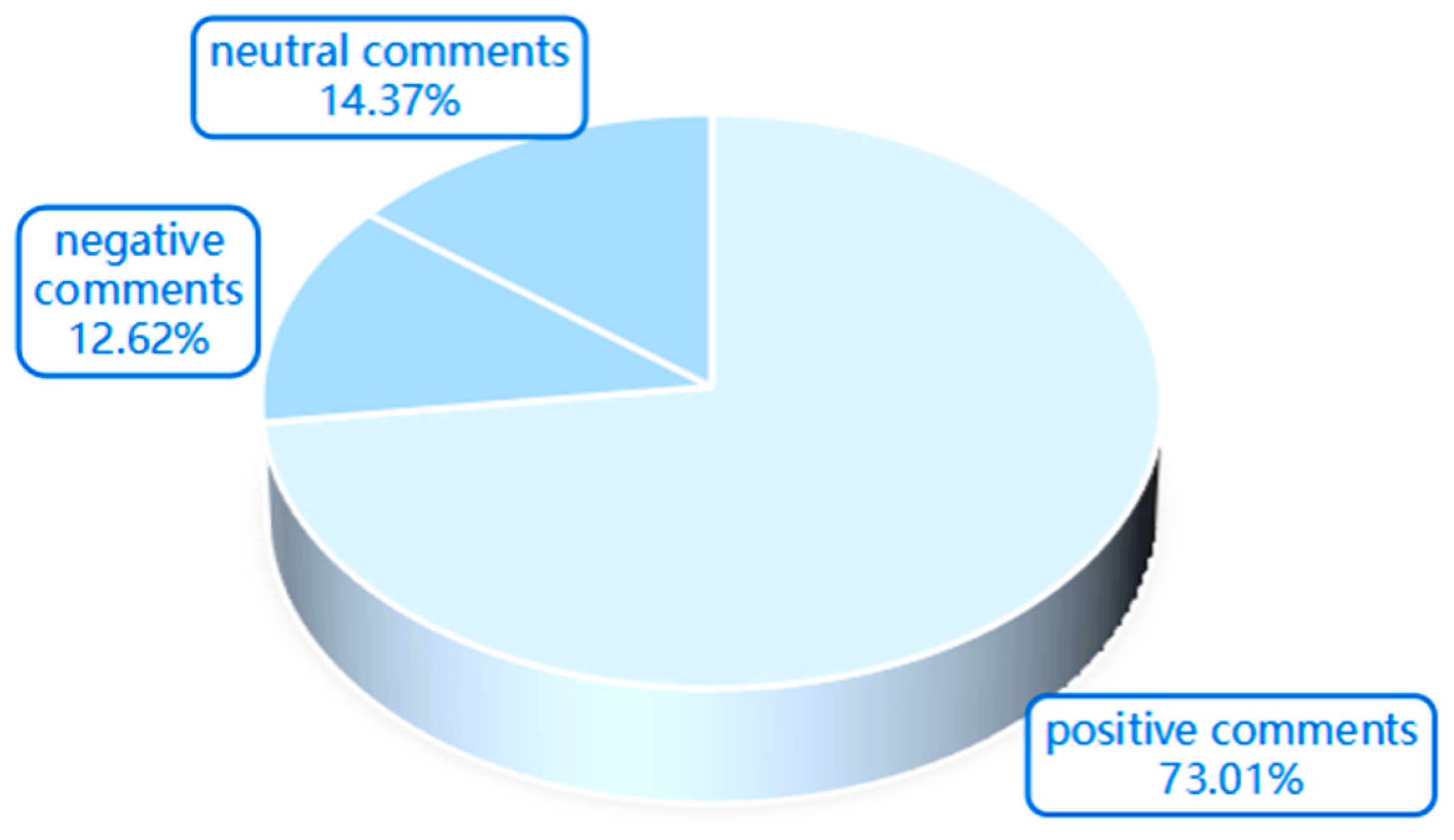
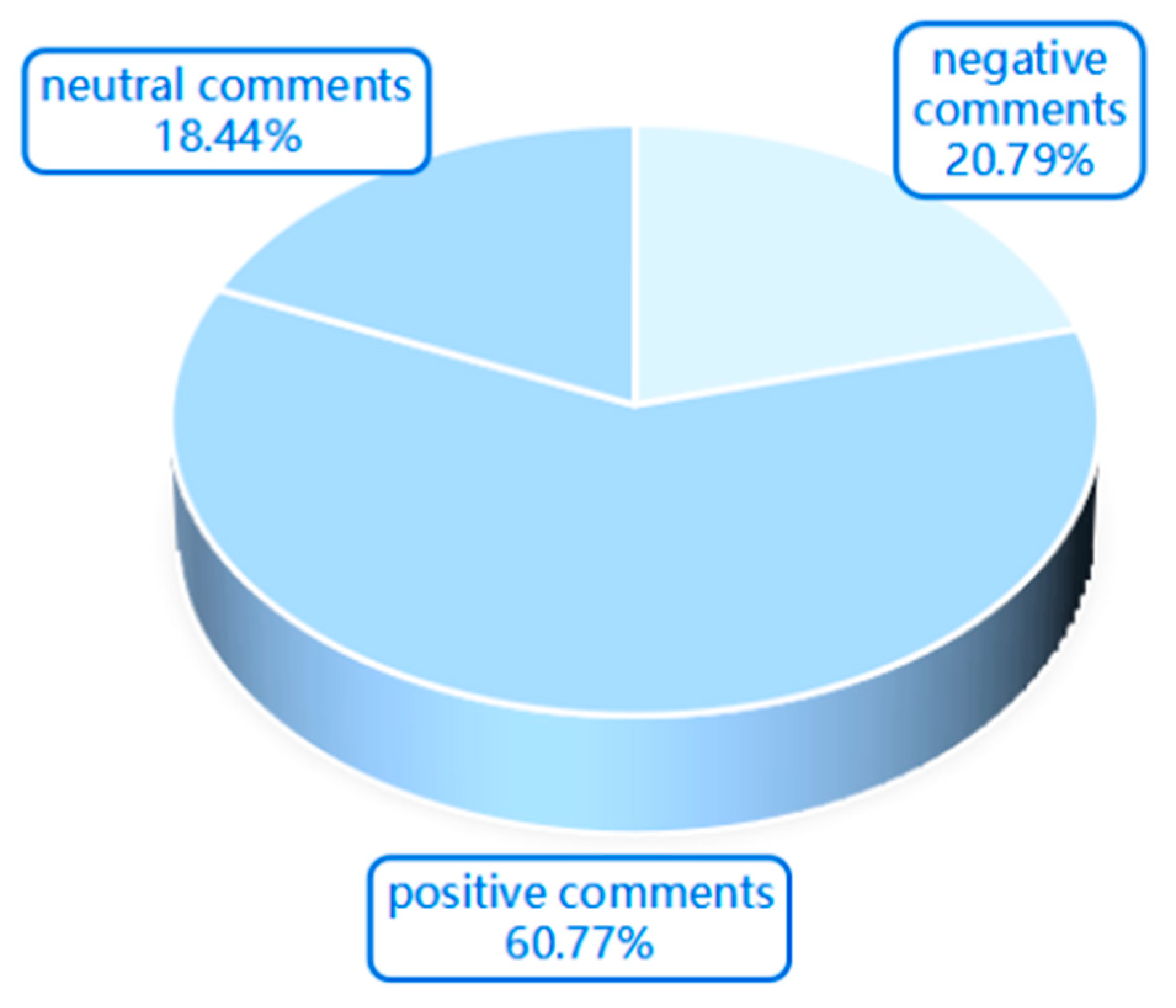
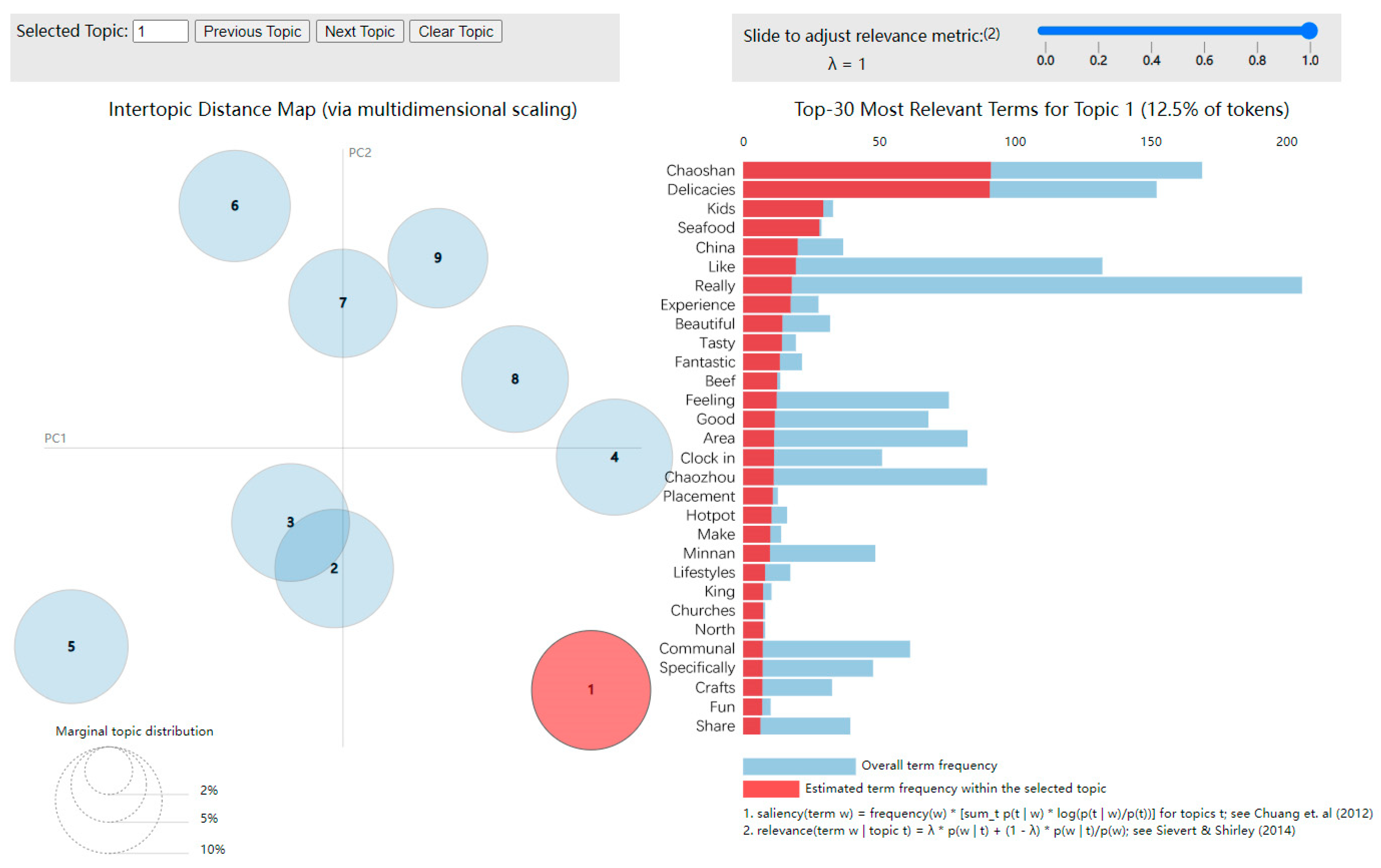
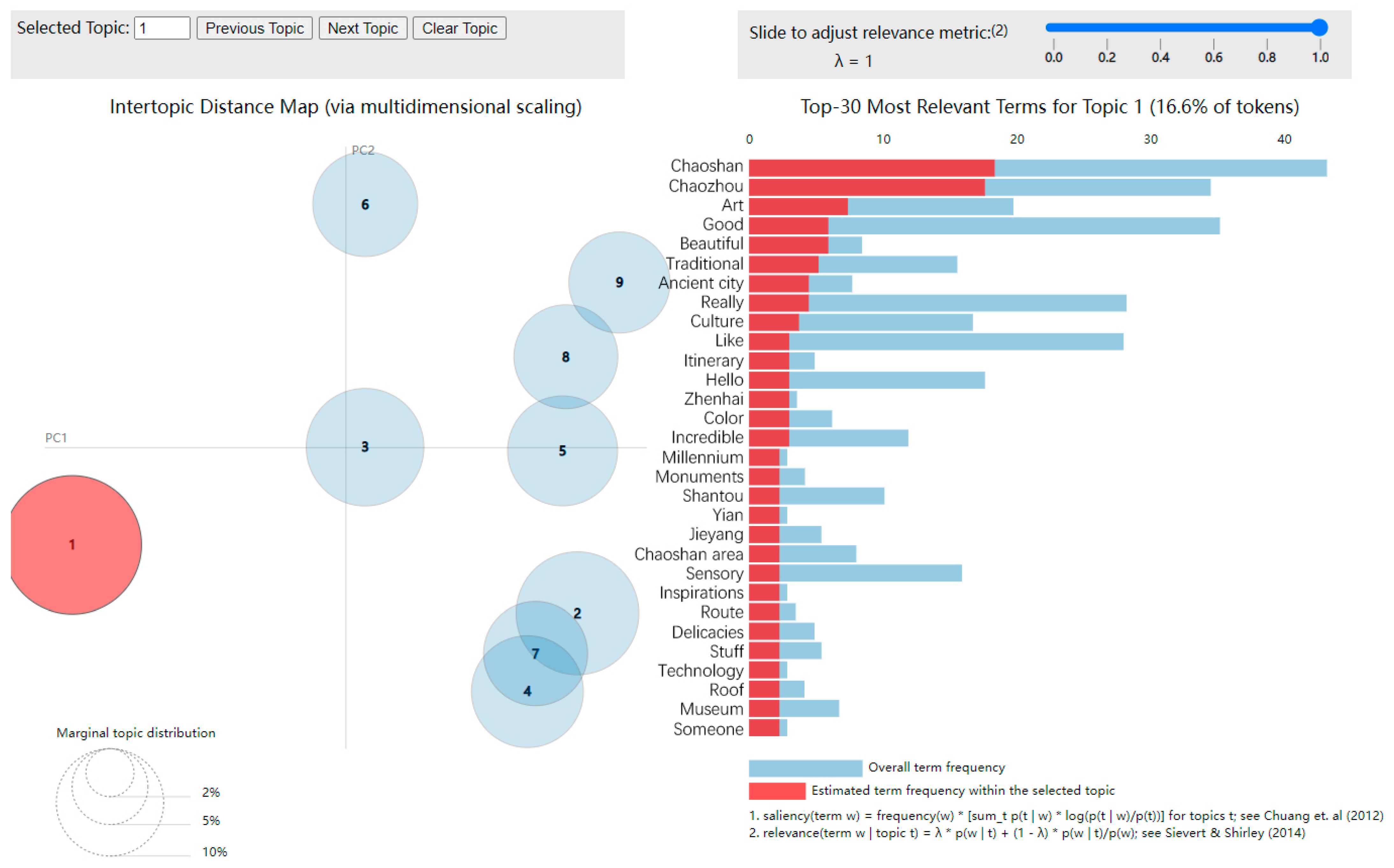
| Ranking | Keyword | Frequency | Ranking | Keyword | Frequency | Ranking | Keyword | Frequency |
|---|---|---|---|---|---|---|---|---|
| 1 | Chinese porcelain inlay | 3408 | 21 | Puning | 485 | 41 | Archway | 290 |
| 2 | Chaozhou | 2598 | 22 | Stone carving | 440 | 42 | Artists | 282 |
| 3 | Chaoshan | 1926 | 23 | Temple | 430 | 43 | Style | 265 |
| 4 | Architecture | 1574 | 24 | Ancient building | 429 | 44 | Ancestral Hall | 265 |
| 5 | Culture | 1216 | 25 | Cultural heritage | 419 | 45 | One | 256 |
| 6 | Decoration | 1128 | 26 | Material | 410 | 46 | Exquisite | 243 |
| 7 | Art | 1119 | 27 | Inlay | 404 | 47 | Ceramics | 239 |
| 8 | Tradition | 912 | 28 | Modeling | 401 | 48 | Colors | 239 |
| 9 | Shantou | 889 | 29 | Character | 401 | 49 | Guangdong Province | 228 |
| 10 | Video | 792 | 30 | Jieyang | 400 | 50 | Taiwan | 226 |
| 11 | Woodcarving | 758 | 31 | Travel | 380 | 51 | Tailoring | 224 |
| 12 | Guangdong | 737 | 32 | Features | 370 | 52 | Life | 224 |
| 13 | Porcelain | 678 | 33 | Photography | 365 | 53 | Lingnan | 220 |
| 14 | Crafts | 669 | 34 | Intangible cultural heritage | 360 | 54 | Stories | 218 |
| 15 | Ancestral Hall | 666 | 35 | Residential buildings | 350 | 55 | Chongqing | 218 |
| 16 | China | 632 | 36 | Chaoshan area | 328 | 56 | Decoration | 214 |
| 17 | Works | 625 | 37 | Roof | 325 | 57 | Temple | 214 |
| 18 | Roof | 624 | 38 | National level | 319 | 58 | Flowers and Birds | 210 |
| 19 | History | 556 | 39 | Inheritance | 314 | 59 | Folk | 209 |
| 20 | Museum | 547 | 40 | Skills | 300 | 60 | Ancestral Hall | 200 |
| Ranking | Keyword | Frequency | Ranking | Keyword | Frequency | Ranking | Keyword | Frequency |
|---|---|---|---|---|---|---|---|---|
| 1 | Chinese porcelain inlay | 202 | 4 | Chaozhou | 117 | 7 | Works | 68 |
| 2 | Chaoshan | 153 | 5 | Architecture | 86 | 8 | Culture | 54 |
| 3 | Art | 125 | 6 | Decoration | 77 | 9 | Tradition | 47 |
| Number-Topic | Topic Keywords |
|---|---|
| Theme 1: Arts and Crafts | Really nice; exquisite; craftsmanship; roof; so beautiful; archway; porcelain carving; wood carving; decoration; tradition |
| Theme 2: Leisure and Entertainment | Chaoshan; food; children; seafood; experience; delicious; beef; check-in; hot pot; fun |
| Theme 3: Cultural Travel | Features; art; beautiful scenery; route; color; navigation; gorgeous; departure; culture; take me to |
| Theme 4: Online Appreciation | like; place; architecture; special; beautiful; travel; world; interesting; video; home |
| Theme 5: Heritage Protection | Feeling; culture; worth; support; temple; appreciation; Chinese porcelain inlay; been; protection; Lingnan |
| Theme 6: Dissemination Scope | Chaozhou; Chongqing; Taiwan; Fujian; Southern Fujian; Chinese Mainland; Guangzhou; Guangdong; Sichuan; Thailand |
| Theme 7: Prayer and Blessing | Blessing; good health; Mazu; peace; gods; protection; Lord; smooth; health; good weather |
| Theme 8: Inheritance and Innovation | Subway; cool; beautiful; inspiration; awesome; handmade; ask; school; awesome; teacher |
| Theme 9: Collection Research | Politeness; place; purchase; research; too beautiful; popular science; shocking; porcelain; adhesive; interest |
Disclaimer/Publisher’s Note: The statements, opinions and data contained in all publications are solely those of the individual author(s) and contributor(s) and not of MDPI and/or the editor(s). MDPI and/or the editor(s) disclaim responsibility for any injury to people or property resulting from any ideas, methods, instructions or products referred to in the content. |
© 2025 by the authors. Licensee MDPI, Basel, Switzerland. This article is an open access article distributed under the terms and conditions of the Creative Commons Attribution (CC BY) license (https://creativecommons.org/licenses/by/4.0/).
Share and Cite
Li, Y.; Chen, Y. Analysis of Cultural Perceptions of the Intangible Cultural Heritage of Chinese Porcelain Inlay: An Investigation Based on Social Media Data. Information 2025, 16, 124. https://doi.org/10.3390/info16020124
Li Y, Chen Y. Analysis of Cultural Perceptions of the Intangible Cultural Heritage of Chinese Porcelain Inlay: An Investigation Based on Social Media Data. Information. 2025; 16(2):124. https://doi.org/10.3390/info16020124
Chicago/Turabian StyleLi, Yanyu, and Yile Chen. 2025. "Analysis of Cultural Perceptions of the Intangible Cultural Heritage of Chinese Porcelain Inlay: An Investigation Based on Social Media Data" Information 16, no. 2: 124. https://doi.org/10.3390/info16020124
APA StyleLi, Y., & Chen, Y. (2025). Analysis of Cultural Perceptions of the Intangible Cultural Heritage of Chinese Porcelain Inlay: An Investigation Based on Social Media Data. Information, 16(2), 124. https://doi.org/10.3390/info16020124








